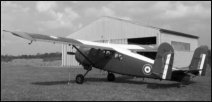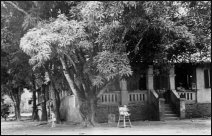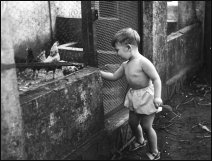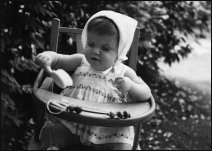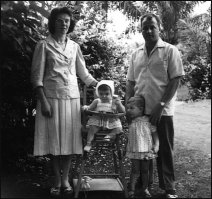|
My years as a pilot.
3. "Central
African Republic : GAMOM 83 "Bethune"
With my wife's agreement, I made a request for a transfer overseas in 1958.
France still had colonies more appropriately called French Community. All these AOF and AEF territories had had
a referendum and where moving toward independence a varying pace. This was the case of Oubangui-Chari which was
part of AEF and became the Republic of Central Africa after its independence in 1959.
And this is exactly where I was appointed to early 1959 at the E.O.M. 83 - Bangui, later G.A.M.O.M. 83 ( i.e.
Aerial Mixed Overseas Group). As all three of us were going, we had to vacate the apartment in La Guerche, put
our furniture in storage, sold the car and packed everything that we would need in our new home. A container with
our excess baggage was sent via ocean fret. We had to wait a long time to have it delivered. Ships were docking
in Pointe-Noire (French Congo). Packages were transported via rail to Brazzaville to make it to Bangui via boat
on the Congo river.
We left from Le Bourget on a UAT DC-6. The trip was pleasant even for Annie and Jacques (1 year old) who had never
flown. The arrival created a major shock. We had left France on February 18th and landed in Bangui under tropical
temperatures. We had a hard time getting used to the weather (especially my family).
We were housed in two different places in town before getting a house on base. It was roomier although not as
well equipped, but the environment was very pleasant: lots of trees including mango and avocado. We always had
bananas hanging under the veranda so we always had delicious bananas ready to eat. We also had chicken house where
we raised small chickens called Batéké that our help prepared in the kitchen. In addition, all the
families were close to one another. This made things easier when the husbands were gone on missions of long term.
Normal assignment length was two years. So, like most families, we looked to purchase a car to do our shopping
in town that was 3 miles (5 km) from base. We found another Citroen Traction 11 Legère. We never had a
problem with it. Of course we had no plans to go very far as the roads were in pretty poor conditions outside
of town.
Each family hired the help of a local boy. Tradition was that the boy was recommended by the departing family
to the incoming one. If this boy was not available, he made sure to introduce one of his friends as a replacement.
These local boys were very happy to be employed by us, as work was scarce in Bangui. Their salary was modest
yet appreciated especially because they benefited from a bonus in the form of food that often allowed them to feed
their family. They always prepared more than we could eat in order to take it home.
As far as the work was concerned, the squadron had interesting assignments. We had at our disposal a well-known
plane, the twin engine Flamant. Similar to the one used in Avord, this was the 315 version. Better suited for
our type of mission, it could even provide ground support if needed as it was armed with two 50-caliber machine
guns and 2 bomb/rocket racks. We often used our gun on training missions over the Yaka shooting range close to
Bangui.
Crew was composed of one pilot, a radio-navigator and a mechanic. Our most common mission was mail delivery to
remote locations difficult of access during the summer season with its tropical rainfall. We also provided medical
evac for the local population: sickness requiring hospital admission or accidents (among them accidents during
safari).
Along the Dassault Flamant, we were equipped with the MH 1521-Broussard. That plane was very well suited for short
take-off/landing on any clearings long enough to be used as a runway. Every week, we used it to do the mail run
eastward. It took two days but we were going as far as the Sudan border. At each stop, if we happen to land at
mealtime, we were invited by the local administrators to have lunch or dinner with them.
Missions with the Flamant included the weekly mission to Birao, north of Bangui was also a 2 days trip. There,
the region administrator would sometimes put his Land Rover and driver to our disposal for some small game hunting.
You could find a lot of small birds in the brush. In fact I had a friend (Lachaume) who was based in Orleans
and who often flew to AEF bring my hunting riffle from my parents
At that time, safaris were very popular in Central Africa. Ivory tusks were taxed but still legal to trade. Some
of us would buy some and bring them back more or less legally. We also had the opportunity to fly over large herds
of buffaloes, elephants, hippopotamus and different bread of antelopes.
During our layover in outposts, we often came in contact with colorful characters like "Caiman" a crocodile
hunter or Orgeix Knight, a well-known adventurer. He had the habit of placing himself at the very end of the runway,
arms spread out as we just had enough runway to take-off. As we knew that he wouldn't move, we had to rip the
plane of the ground at the last moment to avoid hitting him. I had the unfortunate privilege to experience this
kind of stunt against my will of course!
August 59 saw the birth of our daughter Monique. With the summer climate, the birth was difficult both for the
baby and the mother. In fact, even with a vacation on the seaside of Pointe Noire, my family had to return to
France in July 1960. I found myself alone for the remaining six months of my assignment.
We took part in some multi service branches of the French military in the north of Tchad, in the Tibesti region,
south of the Libyan border. These regions were so beautifully rugged and untouched by mankind. Cameroun was also
wild although it was touched by an ethnic guerilla. The French airforce was providing ground support to the local
troops. In our case, it was mainly the T-6 Squad from the GAMOM 83. Flamant and Broussard were also sent to Douala
for various recon and photo missions. I was sent three times to perform these missions in Cameroon. They lasted
8-10 days. In fact it was especially hard on the families as the pilots were busy and didn't have time to think
about it. Thankfully, solidarity kicked in when the husbands were out.
In December 1960, we were expecting our third child. Sadly, our little girl, Isabelle, only lived a couple of
hours. This was another difficult period especially since we were apart. I couldn't go back to France until my
assignment was over in February 61. So, on February 18th 1961, two years to the day after our arrival, I boarded
a plane for Le Bourget where I landed the next day. Annie came to pick me up. We had been separated for seven
months and her life had not been smooth sailing.
After my family had left Bangui, I sold our Traction AV as I didn't need it any longer. In anticipation of my
return we had ordered a Panhard PL17. We were to pick it up in Paris. After a couple setbacks, we finally had
the car in the evening Quai de Javel and left Paris without any further problem. We none-the-less decided to stay
the night somewhere in the Champagne region and drive to St-Dié the next day. We happily were reunited
with the kids and in-laws.
I had my end of assignment vacation after my two years in Bangui. I was now administered by Nancy-les-Essey.
After all our health mishaps, probably due to our hectic family life, I asked to have my partial retirement and
leave the Airforce. I had by then 16 years and was eligible. With that in mind, I had studied for an associate
degree in accounting and had registered in St-Dié in order to take the exam. I passed and was ready to
get a job once liberated from my military duties. I was very disappointed when I learned that in place of retiring,
I was assigned to Algeria. This meant that I would be gone at least 18 months away from my family. The Algerian
conflict was in full swing and it was out of the question for my family to join me there.
While taking my annual physical for flying personnel, I was grounded for three months due to arthritis. I was
treated at the Nancy hospital. At the end of my leave, I rejoined the Nancy-les-Essey airbase without any assignment
other than going to the hospital. This situation allowed me to skip town and see my family often. At the end
of the three months, I was put back on flight status and was assigned to the GLA 45 in Boufarik, Algeria.
|
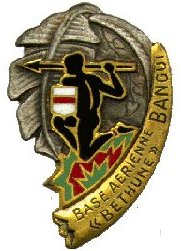
The Bangui Base insignia (elephant tusk, black hunter with assegai)
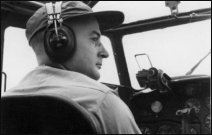
In flight on the Flamant MD-315, from Bangui to Bouar.
|


